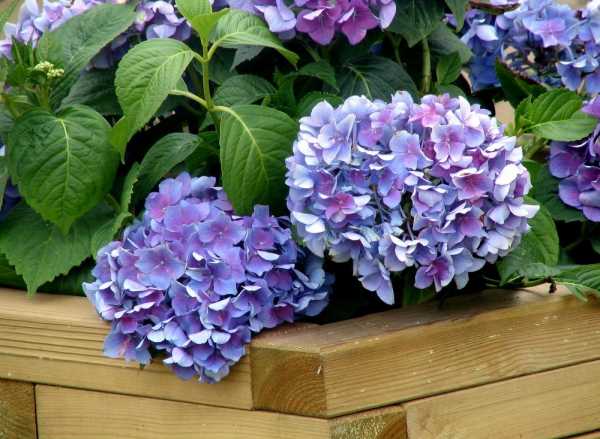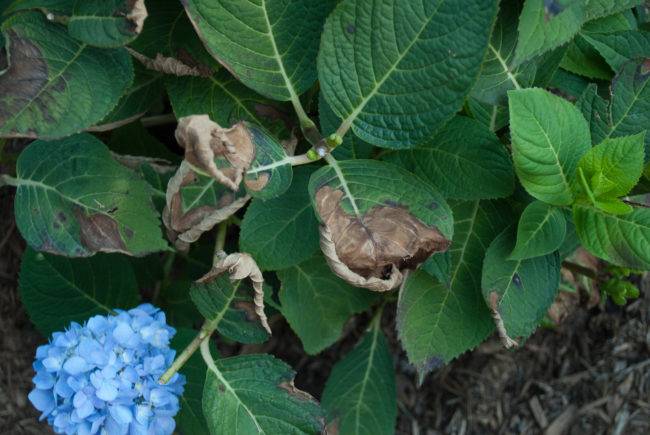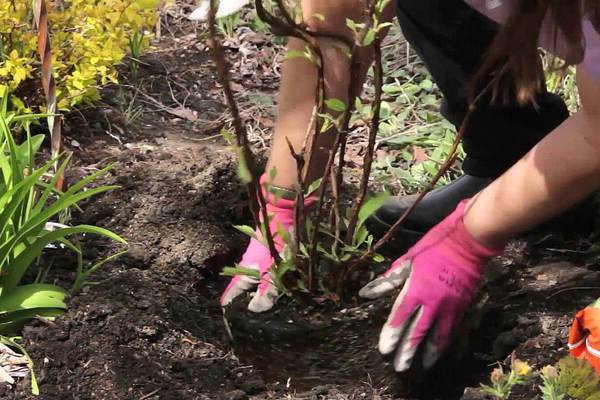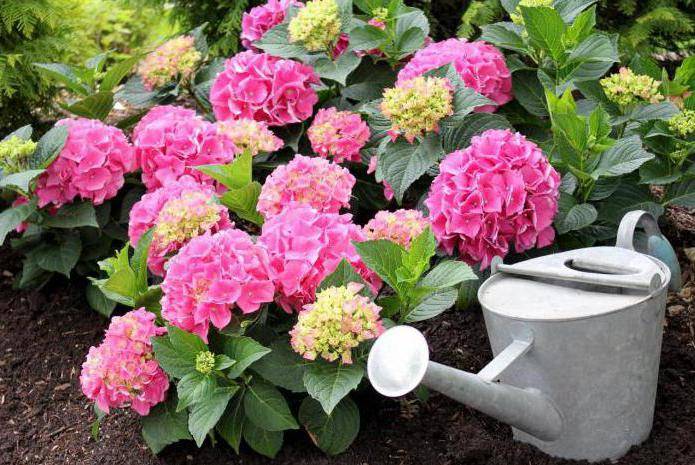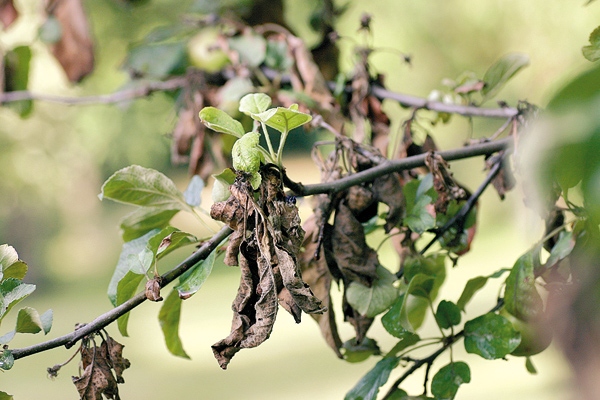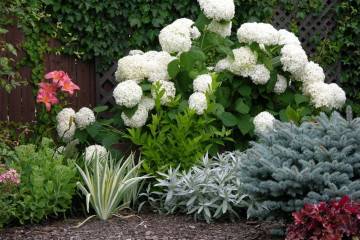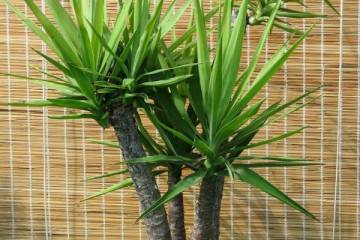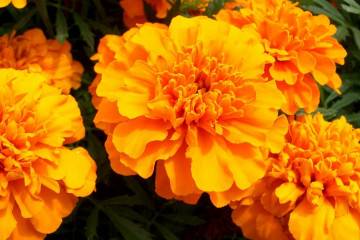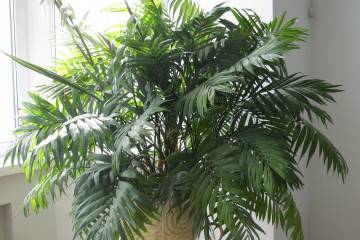Why hydrangea leaves dry around the edges - what to do and how to revive flowers
Content:
Lush hydrangea bushes can suffer from a variety of diseases. In this case, the affected culture may lose its decorative effect. Her leaves often dry and flowers wither. To cope with the problem, you need to understand why hydrangea leaves dry at the edges. This will help you take the right measures in time.
Why do garden or home hydrangea leaves dry around the edges
Any external changes in the condition of the plant indicate improper care. There are many reasons for the appearance of problems. If you find out as quickly as possible why the leaves of the garden hydrangea wither, you can have time to save the plant.
Insufficient soil moisture
The leaves can dry out due to lack of moisture. All varieties of hydrangeas - tree-like, large-leaved, paniculate - are considered moisture-loving. Therefore, they must be watered systematically.
To revitalize street culture, it is worth increasing the amount of watering and using soil mulching. When growing bushes at home, you need to use a humidifier. A container with water, which should be placed near the pot, will also help save the plant.
Excess soil moisture
Due to excessive moisture in the soil, leaves can dry and crumble. The roots, which receive a lot of moisture, rot and die off. As a consequence, leaves that do not receive nutrition can curl and fall off.
How to reanimate hydrangea in this case? When growing a bush at home, you must carefully pull it out of the pot and carefully cut off the affected root fragments. They are brown in color. The treated areas should be sprinkled with activated charcoal.
Then the plant should be transplanted into a new container. It should be smaller than the previous one. Then cover the flower with a greenhouse for 1-2 weeks.
Low air humidity
Answering the question why the hydrangea withers, one cannot but mention the increased dryness of the air. This moisture-loving culture can hardly tolerate it. When grown in the garden, hydrangeas should be sprayed as often as possible. At night, you can create a small greenhouse for a flower.
When growing crops in room conditions, it is worth humidifying the air using a special device.
Excessive lighting
One of the reasons why the edges of the leaves of the hydrangea dry out is the location of the bush in a too sunny place. The bush develops poorly under direct rays. Therefore, the resuscitation of the plant consists in moving it to partial shade or using a special shading grid. When growing hydrangeas in an apartment, it must be placed on the east or west windowsill.
Hypothermia
Hydrangea is a thermophilic crop. It is not recommended to plant it in regions with a cool climate, which is accompanied by a sharp change in weather conditions. Sudden fluctuations in temperature and strong winds cause hydrangea leaves to dry and turn black. In this case, the bush begins to wither and disappear a little.
To cope with the problem, you need to provide the flower with an optimal temperature regime. It should be 20-23 ° C. If the hydrangea is grown in unprotected soil, it should be moved to a large pot and brought into the house.
Heavy or dense soil
If hydrangea is grown, the leaves turn black and dry due to improper soil composition. The culture needs light and loose soil. It should be nutritious enough.
Clay soil does not allow moisture to be removed normally and impairs oxygen circulation around the roots. In such a situation, the bush will experience a lack of nutrients and gradually dry out.
Increased or decreased soil acidity
For the full development of a culture, optimal acidity parameters are required. They should be 4-6 pH. With an alkaline composition of the soil, the leaves will begin to acquire a light shade and dry out.
Lack of micronutrients
Leaves may turn yellow or darken due to a lack of nitrogen or iron in the soil. To avoid such problems, starting in March, the bush must be watered with nitrogen means. At the stage of bud formation, potassium, iron and phosphorus are used. In preparation for winter, potassium-phosphorus agents are used.
Watering with hard water
Another reason why the garden hydrangea withers is the use of hard water for irrigation. It contains a large amount of impurities, including lime. Moreover, hydrangea is highly sensitive to them. Therefore, it is recommended to use settled water for irrigation.
It is advisable to pre-collect liquid in open containers located in the sun. They will provide warm, soft water that can be used for irrigation.
Improper planting or replanting of shrubs
The cause of problems, due to which the tips of the leaves can turn black, may be a violation of the rules for transplanting the culture. In this case, there is a risk of damage to the root system. Also, the plant may die due to the wrong choice of place for planting.
Root damage
The culture has very delicate roots, so it must be transplanted very carefully. In this case, it is important not to damage the small roots, otherwise the bush will hurt a lot.
When planting, it is not recommended to trim the roots. This procedure is carried out only if there are areas of decay or damage by parasites. Affected roots are brown in color, and healthy ones are white.
Wrong location
It is difficult for the plant to adapt to growing in neutral and alkaline soil. Therefore, it is recommended to acidify the soil, otherwise there is a risk of drying out the bush.
Causes of leaf blackening
The appearance of blackening of foliage can be associated with the development of various diseases. To find an effective method of treatment, it is worthwhile to accurately determine the causes.
Dry blackening
Darkening of the tips of the leaves can be attributed to the use of hard water for irrigation and sunburn.In this case, the leaf plates begin to wither and wither.
Wet blackening
The foliage darkens and loses its elasticity due to sharp temperature fluctuations, exposure to drafts, excessive watering, and the use of heavy soil. A fungal infection can also be a provoking factor.
Why do hydrangea inflorescences and flowers dry?
Inflorescences may dry out due to insufficient watering. Also, the cause of problems is often calcium spot. In the first case, it is enough to normalize the moisture of the bushes. At the same time, one cannot get rid of the disease.
Drying branches
Branches can dry out due to various diseases. The most common cause of problems is rot.
White rot
This infectious disease can lead to the death of the culture. Initially, the root system suffers due to excess moisture. Then the nutrition of the bush is disrupted. With the development of the disease, a whitish bloom and blackening of the leaves appear on the bushes. Fungicides will help to cope with it.
Gray rot
With the development of this disease, the tissues of the flower become soft and die off. In a humid environment, they become covered with a gray coating. Diseased culture fragments must be removed. Then treat the plant with Fundazol or Skor.
How to save a hydrangea if it is withered
If affected areas appear on the culture, it is necessary to take timely measures. They depend on where the bush lives.
In the garden
First of all, you need to get rid of the affected fragments. If there is rot, the cut should be done in a healthy area. After pruning, the bush must be sprayed with a fungicidal preparation.
In a pot
An indoor plant must be brought into the house if it was taken outside for the summer. Then you should cut off the affected fragment and process the bush with Hom.
When growing hydrangeas, there is a risk of various problems. To cope with the dryness of the leaves, it is necessary to establish a provoking factor and take action in time.
